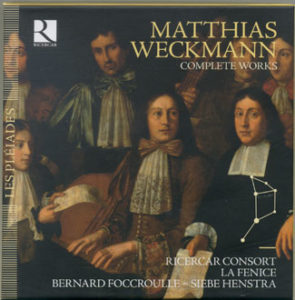More than a decade ago I reviewed a wonderful CPO recording of the Himlische Cantory performing Matthias Weckmann’s sacred music (see reviews archive). As I mentioned then, Weckmann was barely in his teens when his father realized his potential and sent him to study with Schütz (who remained a good friend, traveling companion, and mentor throughout his life) in Dresden, where he became one of Schütz’s star pupils. This association is the primary reason Weckmann is known today, and that’s a shame because among his contemporaries Weckmann was also highly regarded in his own right—and he was quite successful, founding the Collegium Musicum Hamburg as well as holding numerous important church and court positions in Germany and Denmark. While primarily an organist, Weckmann also left a small but impressive collection of original works, many of which receive their premiere recordings here, in this complete 5-CD Ricercar edition.
Weckmann’s sacred works have received the most attention over the years, especially his lengthiest, oratorio-modeled piece, Wie liege die Staadt so wuste (How doth the city sit solitary). It’s a highly emotional setting utilizing verses mostly from the first chapter of the Lamentations of Jeremiah; the passages exchanged between soprano and bass create an often perilously dramatic dialogue. Soprano Veronika Winter and bass Ralf Grobe fared very well for CPO, as do soprano Maria Zedelius and bass Michael Schopper in my reference recording with the Musica Antiqua Köln (DG Archiv). Here, soprano Greta De Reyghere and bass Max Van Egmond’s performances are equally engaging, and I much prefer the way conductor Jean Tubéry elongates the pacing, creating a tension that effectively heightens the sense of impending doom (many observers believe that the plague that devastated Hamburg earlier that year was Weckmann’s inspiration for the piece).
All of the other sacred settings in their own way have equal merit. While the timings of their performances are identical in Weine nicht (Do not weep), Tubéry and La Fenice’s sharper, more attentive treatment of the central Battaglia is also slightly more engaging compared with their CPO counterparts. New to me is Weckmann’s grandest setting (the only one featuring a choir as well as more vocal soloists than any other), Es erhub sich ein Streit (There was war), stylistically reminiscent of Schütz.
The chamber music is also quite impressive. While reliant on Venetian models that often incorporate winds and brass, there’s generally a more Northern temperament at work here. The Sonata in G major a 3 (No. 10) is playfully reminiscent of Buxtehude’s familiar First Sonata in A. Likewise, the Sonata in G major a 4 (No. 5) shares more in common with what was going on in Germany and Bohemia at the time than anything in the south.
The lieder and keyboard works are the least interesting music of the lot. Again, soprano De Reyghere sings beautifully, though there’s simply not enough variety or range in these songs to distinguish them beyond the formulaic. Weckmann’s keyboard works for harpsichord and clavichord are based mostly on French and Italian models and comparatively do not suffer from any such deficiency. The five Suites are all extraordinarily well crafted, as are the Toccatas and Canzon, strongly indebted to Frescobaldi.
In his day Weckmann was considered to be one of the greatest masters of the organ. Stylistically, he bridges German organ tradition between the generations of Sweelinck and Buxtehude in that he aimed to advance the concept of allowing the music, combined with innovative keyboard technique, the ability to emulate, if not imitate the human voice—in other words, to sing. While Bach, of course, would eventually master this programmatic ideal, Weckmann is often very convincing as well. Compare for instance his two transcriptions on Gelobet seist du Jesu Christ and it’s remarkable how characteristically vocal these musical lines become.
While this edition was released this year to commemorate the 400th anniversary of Weckmann’s birth, the project itself has been in the works for nearly three decades. The keyboard works were recorded in 1988, and while issued on CD in Europe were never released in the U.S. By 1992 when the sacred works were recorded, followed by recordings of the chamber works and lieder in 1995, changes in distribution led to a situation in which these back-catalog titles never made it to the U.S. From May 2012 through September 2013, organist Bernard Foccroulle (who previously recorded the entire organ works of Bach, Bruhns, and Buxtehude for Ricercar) recorded all of Weckmann’s organ compositions, thus completing the project.
The sound is quite good throughout; the recordings of the sacred, chamber, and lieder works in particular are especially lifelike and well balanced. Foccroulle’s recordings of the organ works are audiophile quality. The 102-page booklet is remarkably thorough, offering not only full texts and translations, but a comprehensive appreciation and analysis of Weckmann and his time. I rarely mention price points in reviews, but given that Ricercar is generously offering this edition with a list price of $27.99, I feel I must. All in all, an outstanding tribute to one of the Baroque’s most under-rated, minor masters. Highly recommended.
































